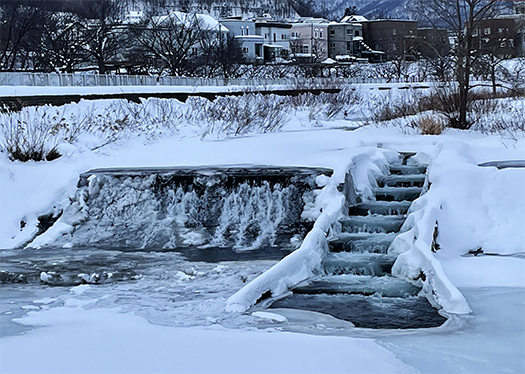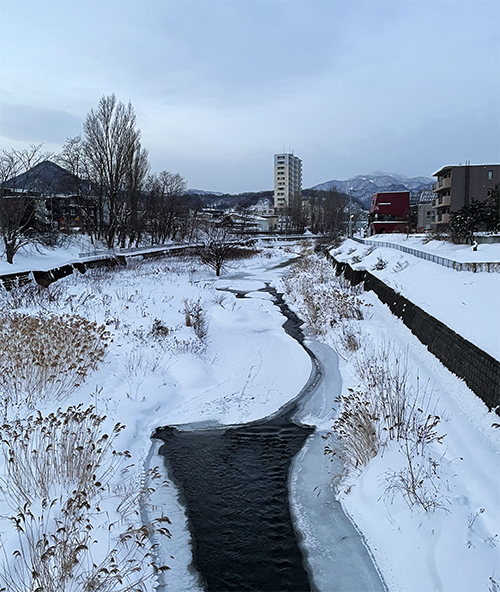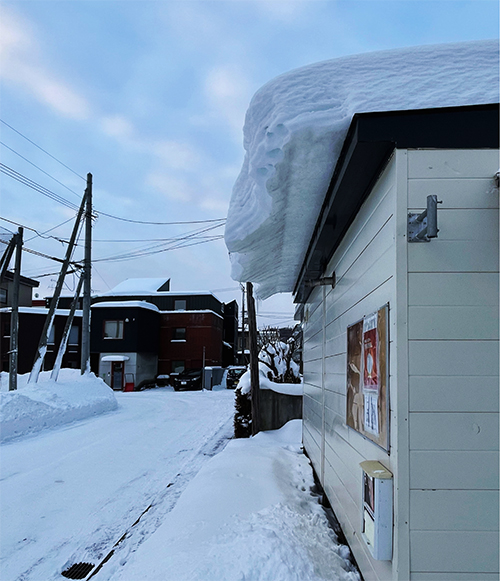

週末は北海道日本海側は風雪が強まるという冬の嵐の予報。いよいよ来るか冬将軍様・・・であります。用心しながら過ごしたいと思いますが、写真はここのところの寒波でのわが家周辺の「冬の景観」です。寒さには独特の美のたたずまいがある。上の写真は発寒川の段差、言ってみれば人工の滝ですが、そこが結氷している様子。だんだんと震え上がるような結氷美を見せてくれるようになる。恐る恐る見るのはやや自虐感があるけれど、寒冷地の人間の密かな楽しみ(笑)。冬でもあったかい家の中と、まっ盛りの冬の寒さがコントラストを暮らしに与えてくれる。その落差が大きいほど、花鳥風月感が深まる・・・。
西行のような詩人が現代の北海道を旅してくれたら、どんな心象風景を謳るか、想像すると面白みがある。やはり高断熱高気密という住環境がほぼ普遍的に獲得されてからは、冬の外部環境を楽しむ余裕が生まれてきて、それなりの体験が熟成してきている。日本人にどんな新・花鳥風月を追加できていくのか、興味を持っている次第。

そういう新・花鳥風月のテーマとして写真のような家と雪氷がもたらすオモシロ風景がある。まぁ、住宅性能的に見ればこれは屋根の断熱が十分ではなくて室内の熱が屋根トタン面にまで漏出し、屋根面で凍結爆裂融雪を繰り返して、結果、屋根端部にずり下がっていく光景。いわゆる「雪庇(せっぴ)」という現象であります。写真は非住居の建物で数日前の撮影ですが、毎年の気温変化・降雪量推移によって千変万化する。屋根の軒先から50-60cm程度張り出している。いまのところ日中最高気温も零下なので、屋根面雪崩は発生していませんが、温度変化によってはそういう危険もあり得る。まだそこまでではないのですが、もうちょっと危険性が高まると警告のコーンが設置されたりする。危険性が「見える化」しているので歩行者のみなさんも充分注意する。寒冷地としての生活常識も存在する。
ただ、わたしの少年期などではこういう雪庇や氷柱などが街中至るところで発生していて、それが当たり前だったから、動物的な危険回避の臨界感覚が育っていたかも知れない。屋根雪崩はだいたい、2−3月の晩冬時期の危険性が高い。とはいえ、冬の期間中こういう軒先付近にはなるべく近づかないようにはすべきでしょう。そういう危険性はあるけれど、一個の造形物と考えるとまことに「冬の風物詩」。ことしの冬のいろいろな気候痕跡が正直に露出しているので、興味深くもある。
さて夜の間にしっかり降ってくれたので、除雪頑張ります(泣)。
English version⬇
Winter, cold weather brings snow and ice beauty and slightly dangerous formations.
A weekend of heavy snowfall. The snowfall was so heavy that my body is screaming from every node. The peak of winter is just around the corner. …
A winter storm is forecast for the weekend, with wind and snow strengthening on the Sea of Japan side of Hokkaido. The winter storm is forecast to intensify wind and snow in the Sea of Japan area of Hokkaido over the weekend. The photo shows the “winter landscape” around our house during the recent cold wave. Cold weather has its own unique beauty. The photo above is a step of the Hassamu River, a man-made waterfall if you will, where the ice is forming. It gradually shows us the beauty of ice formation that makes us shiver, and although it is somewhat self-deprecating to see it with trepidation, it is a secret pleasure for people living in cold regions (laugh). The contrast between the warmth of a house in winter and the coldness of winter at its height provides a contrast to our lives. The greater the difference between the two, the deeper the sense of “kacho-fu-getsu” (flowers, birds, winds, and the moon) becomes.
It is interesting to imagine what a poet like Saigyo would say if he were to travel to Hokkaido today. After all, since the almost universal adoption of a highly insulated and airtight living environment, people have been afforded the luxury of enjoying the external environment in winter, and the experience has matured in its own way. I am interested to see what kind of new “kacho-fu-getsu” (the Japanese traditional seasonal festivals of flowers, birds, and winds) will be added to the Japanese people’s experience of the winter.
One such new Kacho Fugetsu theme is the wacky scenery brought about by the house and snow and ice, as shown in the photo. Well, from a housing performance point of view, this is a scene where the roof insulation is not sufficient and the heat inside leaks out to the tin surface of the roof, causing the snow to freeze, explode, and melt repeatedly on the roof surface, resulting in the snow sliding down to the edge of the roof. This is the so-called “snow eaves” phenomenon. The photo was taken a few days ago on a non-residential building, but it changes drastically depending on annual temperature and snowfall changes. The snow is sticking out about 50-60 cm from the eaves of the roof. At the moment, the maximum daytime temperature is also below zero, so no roof-surface avalanches have occurred, but such a danger is possible depending on temperature changes. It is not to that extent yet, but when the danger increases a little more, warning cones will be installed. Since the danger is “visualized,” pedestrians should be very careful. There is also the common sense of living in a cold region.
However, when I was a boy, such snow cover and icicles were commonplace throughout the city, and I may have developed a critical sense of danger avoidance like an animal. Roof avalanches are usually most dangerous in the late winter months of February and March. Nevertheless, we should try to stay away from such areas near the eaves during the winter months. Despite these dangers, when considered as an artifact, it is truly a “winter wonder”. It is also interesting because it honestly exposes various traces of the winter climate.
Now that it fell during the night, I’m going to work hard to remove the snow.
Posted on 1月 21st, 2023 by 三木 奎吾
Filed under: 住宅マーケティング, 住宅性能・設備







コメントを投稿
「※誹謗中傷や、悪意のある書き込み、営利目的などのコメントを防ぐために、投稿された全てのコメントは一時的に保留されますのでご了承ください。」
You must be logged in to post a comment.